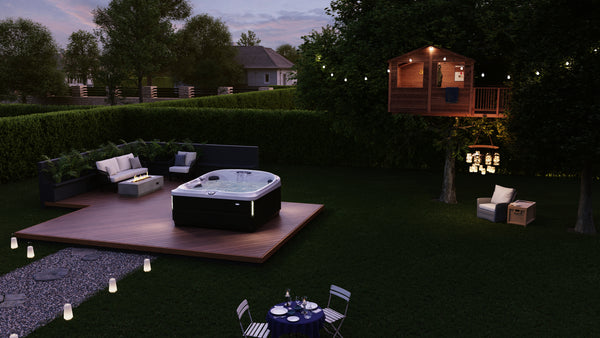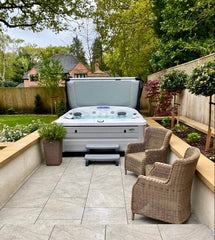Whether you've owned your hot tub for 20 minutes or 20 years, installing safe, law-abiding electrics is vital. We know, we know; you want to relax inside the moment it arrives – and honestly, we would too. However, it's a criminal offense to ignore this part, so we urge you not to skip it.
In a nutshell, your spa's electrics must comply with Part P regulations – specifically section 702 of BS:7671 in the 17th Edition IEE (Institute Of Electrical Engineers).
Don't worry; this isn't as complicated as it sounds. Below, we've jargon-busted the scary-sounding terms. Scroll down to learn everything you need to know (and more) about safely setting up your spa's electrics.

What is Part P?
Back in 2005, the UK government introduced a new law. It demanded that a competent individual perform household electrical work, and they filed this requirement under Part P of the building regulations.
Part P is designed to protect homeowners in England and Wales from poor quality work – the Building Standards System covers Scottish residents. It applies to anyone carrying out fixed electrical installations and states:
Reasonable provision shall be made in the design and installation of electrical installations in order to protect persons operating, maintaining or altering the installations from fire or injury.
Who is responsible for ensuring electrical work meets Part P requirements?
If you own your home, it's your responsibility to prove that your new electrics meet Part P requirements, as defined in the BS:7671 wiring regulations. Or, if you rent your home, it's your landlord's responsibility.
How do I ensure my Part P requirements are met?
When getting your new hot tub installed, you have three choices.
- Contract a Part P qualified and registered electrician which can be found through one of the following schemes:
- NICEIC – www.niceic.com
- NAPIT – www.napit.org.uk
- ELECSA – www.elecsa.co.uk
- Your electrician can employ a qualified and registered electrician to inspect their work. This removes the need for a local authority inspection.
- A fully qualified but unregistered electrician can inspect their work or employ a qualified electrician to check it.
On completion, you'll be given a Part P certificate. This must be stored in a safe place, and if you sell your home, it will be required as part of the Home Seller's Pack.
How many amps do you need for a hot tub?
Most small hot tubs need 13 amps to function properly, while large spas require a 32 amp supply. Just read your tub's technical specifications to learn more. Or, at your request, we'll liaise with your contractor on your behalf.

13 amp electrical requirements
These plug-and-play hot tubs are very straightforward. We'll provide you with five metres of cabling; just plug this into an outdoor RDC socket.
32 & 40 AMP electrical requirements

For 32 amp tubs, you'll need a 6mm² 3-core SWA cable. Or, for 40 amp tubs, a 10mm² 3-core SWA cable.
Top tip: We recommend installing an IP65 45 amp rotary isolator switch, so your spa can be isolated during an emergency or service work. This switch must be placed at least two metres away from the tub to stop bathers from touching it.
Your electrician should fit a weatherproof block connector to the end of the isolator tail, allowing the energy supply to be hard-wired into your tub. Use waterproof gland packs to prevent water ingress on all electrical connections (two at the isolation switch). And ensure that all earth cables are colour coded with green and yellow insulation tape, or feature an earth sleeve.
What are the electrical requirements for a hot tub?
Hot tubs installed in the UK after 2005 must comply with the following criteria:
- The hot tub must be hard-wired on its own fused spur back to your household consumer unit, not sharing a supply with any other appliance.
-
The hot tub should be protected by a sufficiently rated MCB (mains circuit breaker) and cover the maximum amperage pull of the spa plus 25% to allow for brake torque, i.e. the extra rush of current when pumps are started. Therefore, a hot tub with a maximum current draw of 20 amps requires a 25AMP MCB.

- The hot tub should be protected against earth faults by an RCD (Residual Current Device). This is a trip switch that prevents electric shocks from damaged or waterlogged cables and connections. We recommend an RCD of 30mA.
- Outdoor cabling must be protected from damage by either laying protective ducting (pc pipe) below ground or by using SWA cable (Steel Wired Armoured). Your electrician will calculate the size of cable required depending on the loading and the distance from the main supply.
Once your hot tub has been connected to the electricity supply and filled with water, your installation team will check everything is operational. On success, they should give you a complete chemical training guide and a tour of the hot tub's features.
Please note: Your electrician should leave enough spare cable attached to the isolator to reach the farthest side of your hot tub. But if in doubt, our expert team is just a phone call away.
Parting advice
And there you have it; our quick and easy guide to your hot tub's electrical requirements. If you're unsure about any of the above rules, just get in touch.
We've installed thousands of hot tubs over the years; read our testimonials from our happy customers. Or, to request a service, please call us on 01482 212322 or visit our hot tub service page.
If you’re looking for a new hot tub you can visit our Yorkshire hot tub showrooms, explore our virtual showroom or book a video call with our showroom team.
Stay up to date with our latest products, hot tub guides and updates on Facebook or Instagram.





